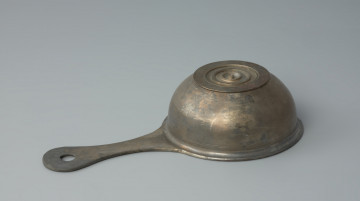
Decorated saucepan
National Museum in Szczecin
Part of the collection: Antiquity
The design of this silver brooch used for fastening clothes was inspired by Roman fibulae of Aucissa type from the 1st century. Its bow is decorated with golden balls. It was a part of the furnishing of one of the barrows discovered in the cemetery in Lubieszewo (Gryfice poviat). The deceased members of the tribal aristocracy were buried with valuable possessions in burial chambers made of wood or stone, covered with earthen mounds and stone pavements. The barrow graves in Lubieszewo were discovered by accident during agricultural works and were examined only amateurishly in 1908, 1910 and 1913. The discovery was reported to the Szczecin conservator, Adolf Stubenrauch, who visited the site on behalf of the Society for Pomeranian History and Antiquity (Gesellschaft für Pommersche Geschichte und Altertumskunde). No methodical excavations have ever been carried out within the cemetery. Three more barrows were discovered again by accident in 1925, and the grave goods found at that time were recovered by Otto Kunkel from the museum in Szczecin, thanks to the intervention of a local teacher. A limited archaeological survey was carried out by the Szczecin archaeologist Hans Jürgen Eggers only in 1937-1938.
Bartłomiej Rogalski
Author / creator
Dimensions
cały obiekt: height: 2.4 cm, width: 5.6 cm
Object type
pin (fastener)
Technique
forging; cast
Material
gold-plated silver
Creation / finding place
Owner
Muzeum Narodowe w Szczecinie
Identification number
Location / status